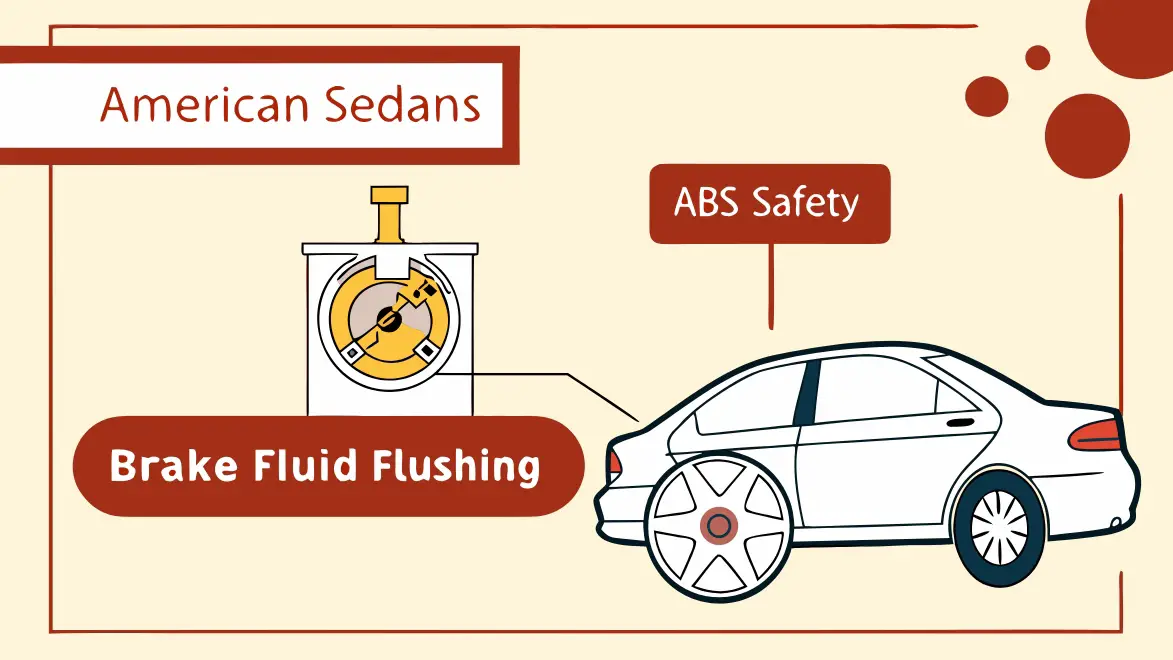Introduction: Brake Fluid—The Forgotten Lifeline of Your Car’s Safety
When most car owners think about routine maintenance, they remember oil changes, tire rotations, and even transmission flushes. But brake fluid flushes? Often overlooked. Yet brake fluid plays a critical role in modern cars, especially with ABS (Anti-lock Braking System) technology.
Without proper brake fluid maintenance, you risk:
- Brake fade
- ABS malfunction
- Brake failure in emergency stops
This is especially true for American sedans, which rely heavily on integrated braking and traction systems. Let’s break down why and how often you should flush your brake fluid to keep your ABS reliable and your car safe.
What is Brake Fluid and What Does It Do?
Brake fluid is a hydraulic fluid that transfers force from your brake pedal to the calipers or wheel cylinders, which in turn apply pressure to your brake pads or shoes.
It must:
- Remain incompressible
- Tolerate extreme heat (300–400°F)
- Resist water contamination (which reduces boiling point)
- Flow quickly for real-time ABS response
There are multiple grades, but DOT 3, DOT 4, and DOT 5.1 are common in American sedans.
Why Brake Fluid Needs to Be Flushed
Brake fluid is hygroscopic, meaning it absorbs moisture from the air. Over time, even in sealed systems, this moisture:
- Lowers the boiling point
- Corrodes internal components
- Compromises ABS valves and sensors
Infographic: Boiling Point Drop Over Time Without Flushing
DOT 4 Brake Fluid starts at ~401°F.
After 3 years, it can drop to below 290°F, making vapor lock likely during hard braking or high-load conditions.
ABS Systems: Why They Rely on Clean Fluid
ABS systems use high-speed valves and a pump to rapidly apply/release pressure during wheel lockup. Contaminated or water-logged fluid can:
- Trigger ABS warning lights
- Prevent the ABS pump from activating
- Cause erratic pedal feel or pulsing
- Fail during emergency stops
According to NHTSA, more than 25% of brake-related issues in sedans involve compromised ABS performance.
So, How Often Should You Flush Brake Fluid?
Here are general guidelines (consult your owner’s manual):
| Vehicle Type | Flush Interval |
|---|---|
| New Sedans (2018+) | Every 3 years or 30,000 miles |
| Older Models (pre-2015) | Every 2 years |
| Performance/Turbo Sedans | Every 1–2 years |
| After Heavy Towing or Mountain Driving | Immediately post-season |
Signs You Need a Brake Fluid Flush Now
- Spongy Brake Pedal
- Longer Stopping Distances
- ABS Warning Light
- Dirty/Discolored Fluid (Brown or Black)
- Burning Smell After Braking
Check your brake fluid reservoir—clean fluid should be clear to light yellow.
Cost Breakdown: Brake Fluid Flush
| Service Type | Estimated Cost |
|---|---|
| DIY Brake Bleed Kit | $25–$50 |
| Shop Brake Flush | $90–$150 |
| Dealership ABS Flush | $150–$250 |
| Emergency ABS Valve Replacement (if neglected) | $600–$1,000+ |
Case Study: Ford Fusion ABS Failure Due to Old Fluid
Vehicle: 2015 Ford Fusion SE
Symptoms: ABS light on, mushy pedal, hard braking fade
Cause: 5+ year-old fluid, water content >4%
Result: ABS pump failure
Repair Cost: $960
Lesson: Skipping a $120 flush cost this owner nearly $1,000 in repairs.
How to Flush Brake Fluid (Step-by-Step DIY Overview)
Only attempt if you’re confident with automotive work. Always follow vehicle-specific instructions.
Tools Needed:
- Jack and jack stands
- DOT 3/4 brake fluid (check manual)
- Brake bleeder kit
- Wrench set
- Clear tubing + catch bottle
Steps:
- Lift and secure the car
- Locate bleed screws on all calipers
- Start from the wheel farthest from the master cylinder (usually rear passenger)
- Attach clear hose, open bleed screw, and pump brakes
- Watch for new, clean fluid
- Repeat on all corners, checking fluid reservoir often
- Top off and test brakes
DIY Flush Time: ~60–90 minutes
Brake Fluid Test Strips
For ~$10, you can buy test strips to measure:
- Moisture content
- Copper levels (indicates corrosion)
- Fluid condition (color, pH)
Flush if:
- Moisture >2%
- Color is dark brown
- You haven’t changed fluid in 3+ years
Brake Fluid & ABS Compatibility Tips
- Never mix DOT 3 and DOT 5 (they are chemically different)
- Use OEM-recommended fluid only
- Check if your vehicle uses DOT 4 LV (low viscosity) for cold-weather performance
- Replace rubber bleeder caps to avoid contamination
Long-Term Brake Fluid Maintenance Tips
| Habit | Result |
|---|---|
| Flush every 2–3 years | Prevents corrosion & ABS failure |
| Use sealed brake fluid containers | Avoids moisture contamination |
| Check during oil changes | Spot early color changes |
| Replace bleeder screws if corroded | Ensures smooth flushing |
FAQ: Brake Fluid Flushing & ABS Safety
Q1: Can I use synthetic brake fluid in my sedan?
A: Only if your vehicle specifically allows DOT 5.1 or synthetic. Most American sedans use DOT 3 or 4.
Q2: Is a flush the same as a bleed?
A: No. A bleed removes air; a flush replaces all fluid. Both may be needed.
Q3: Does ABS engage every time I brake?
A: No. ABS only activates in rapid, hard stops or slippery conditions.
Q4: Can I tell if my fluid has too much water?
A: Not by eye. Use test strips or a brake fluid tester.
References and Expert Resources
- NHTSA Brake System Safety Reports
- Bosch ABS System Technical Guide (PDF)
- AAA Car Maintenance Study 2022
- SAE Technical Paper 2021-01-1095 – “Hydraulic Brake System Corrosion”
- CarCare.org – “Brake Fluid: What You Need to Know”
Conclusion: Small Fluid, Big Safety Impact
Brake fluid is easy to ignore—but it’s a silent enabler of safe driving and ABS performance. Flushing your brake fluid every 2–3 years is not just smart maintenance—it’s a life-saving investment in your vehicle’s most important system.
If you drive an American sedan like a Fusion, Malibu, or Accord, keeping your ABS healthy means keeping your brake fluid clean.

